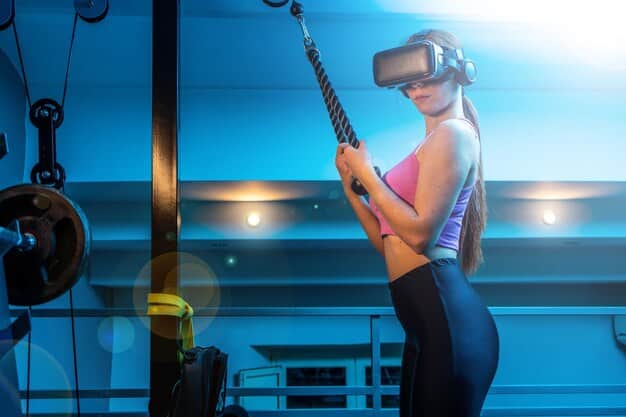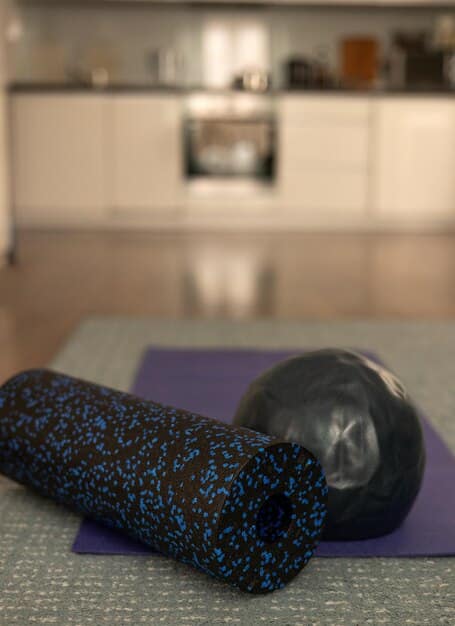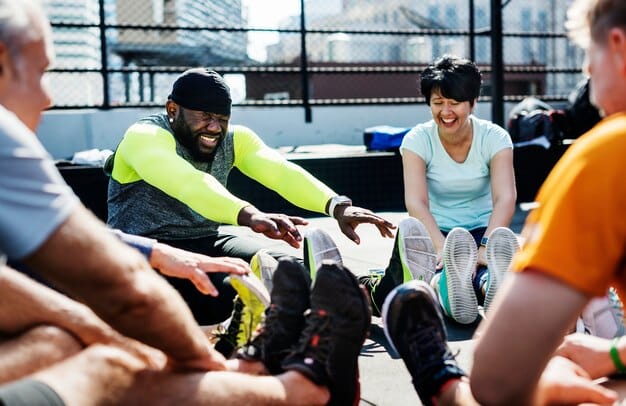5 New Fitness Trends in the US for 2025

Five emerging fitness trends in the US, including AI-powered personalized training, climate-adapted workouts, micro-gyms, holistic recovery methods, and metaverse-integrated fitness, are set to redefine the wellness landscape by 2025.
The fitness world is in constant flux, evolving with technological advancements and shifting societal needs. As we look towards 2025, a wave of innovative trends is poised to transform how Americans approach health and wellness. These aren’t just fads; they represent significant shifts in exercise philosophy and practice, offering new opportunities for engagement and profound personal gains. Get ready to explore the 5 New Fitness Trends in the US That Will Dominate 2025 and discover what your future workouts might look like.
AI-Powered Personalization and Adaptive Training
The era of one-size-fits-all fitness is rapidly receding, making way for hyper-personalized experiences driven by artificial intelligence. AI’s capacity to analyze vast amounts of data—from individual biometric readings to daily activity levels and nutritional intake—allows for the creation of truly bespoke training programs. This isn’t just about suggesting exercises; it’s about dynamic adaptation in real-time, optimizing every session for maximum effectiveness and injury prevention.
AI platforms are becoming sophisticated coaches, learning individual preferences, identifying strengths and weaknesses, and adjusting intensity and volume on the fly. This level of responsiveness was once accessible only through expensive human coaching, but now, advanced algorithms are putting it within reach for many. Beyond workout prescription, AI is also revolutionizing recovery protocols, recommending optimal nutrition, and even predicting potential overtraining or injury risks.
The Rise of Adaptive AI Systems
Adaptive AI systems are at the forefront of this revolution, continuously refining their understanding of each user. They monitor progress, recognize plateaus, and recommend nuanced adjustments to maintain momentum and combat stagnation. This constant feedback loop means your fitness plan is never static, but an evolving blueprint for success.
* Real-time Feedback: Sensors and wearables feed data directly to AI, allowing immediate adjustments to form or intensity.
* Personalized Progression: Workouts scale automatically based on performance, preventing overtraining or under-challenging.
* Injury Prevention: AI analyzes movement patterns to identify potential ergonomic issues before they lead to injury.
* Nutritional Guidance: Integration with dietary tracking apps provides tailored dietary recommendations complementing training goals.
The implications for adherence and long-term success are profound. When a fitness regimen feels custom-built and responds to your body’s specific needs, motivation naturally increases. This personalized touch removes many of the common barriers to consistent exercise, turning daunting fitness goals into achievable, integrated lifestyles.
AI-powered personalization isn’t just for elite athletes; it’s democratizing access to highly effective training. These systems offer the insights of a world-class coach to anyone with a smartphone and a fitness tracker, enabling a deeper, more engaging, and ultimately more effective fitness journey for millions across the US.
Climate-Adapted Workouts and Outdoor Resilience Training
As climate consciousness grows and extreme weather events become more common, the fitness industry is responding with innovative approaches to outdoor training. Beyond simply enduring the elements, this trend focuses on adapting workouts to specific environmental conditions and developing physical resilience to climate variability.
This isn’t just about moving your gym session outdoors; it’s about purposefully incorporating environmental factors into your training. Think heat acclimation protocols, cold-exposure techniques, and even altitude simulation for those in urban areas. The goal is to condition the body to perform optimally, regardless of the challenges presented by nature. This also ties into a growing desire for more experiential and less controlled fitness environments.
Embracing Nature’s Challenges
This trend encourages individuals to view natural environments not as obstacles, but as dynamic training grounds. It involves thoughtful planning and specialized methodologies to maximize benefits while minimizing risks associated with varying temperatures, humidity, or air quality.
* Heat Acclimation: Specific training protocols designed to improve the body’s ability to cope with high temperatures, including moderate intensity workouts in warmer conditions.
* Cold Exposure: Utilizing techniques like cold showers, ice baths, or outdoor activities in cooler weather to boost circulation and metabolic rate.
* Altitude Training: For those without access to mountains, specialized oxygen deprivation masks or simulated altitude chambers are gaining traction to enhance endurance.
* Elemental Movement: Incorporating traditional movements like climbing, crawling, and natural obstacle courses that build comprehensive functional strength.
The psychological benefits are equally compelling. Training outdoors connects individuals with nature, reducing stress and enhancing mental well-being. It fosters a sense of resilience that extends beyond physical capability, promoting adaptability in everyday life. For urban dwellers, these practices offer a vital escape from concrete jungles and a return to more primal, intuitive forms of movement. This blending of environmental awareness with physical fitness marks a significant shift towards a more holistic understanding of health and human potential.
The Rise of Micro-Gyms and Community-Centric Spaces
In a post-pandemic world, the appeal of large, impersonal gym chains is diminishing for many, giving way to a preference for smaller, more intimate fitness spaces. Micro-gyms are not just smaller versions of traditional gyms; they represent a fundamental shift towards community, specialized training, and personalized attention. These boutique studios often focus on specific modalities, whether it’s highly specialized strength training, unique dance fitness, or targeted mobility work.
These spaces thrive on creating a strong sense of belonging, often fostered through smaller class sizes, dedicated instructors who know their clients by name, and a communal atmosphere that encourages support and camaraderie. The overheads are typically lower, allowing for more competitive pricing or reinvestment into high-quality equipment and expert coaching. This model caters to those seeking a more curated, less overwhelming fitness experience.
Building Fitness Through Connection
The success of micro-gyms lies in their ability to cultivate genuine connections among members. These aren’t just places to work out; they become social hubs where individuals with shared interests motivate and uplift one another.
* Niche Focus: Specialization in areas like powerlifting, calisthenics, aerial yoga, or martial arts creates a dedicated community.
* Personalized Attention: Smaller classes and trainer-to-client ratios allow for more tailored instruction and feedback.
* Stronger Community Bonds: Regular group events, workshops, and shared challenges foster a sense of belonging missing in larger gyms.
* Local Accessibility: Often established in local neighborhoods, making them convenient and integrated into daily life.
This trend reflects a broader societal movement towards authenticity and connection. People are increasingly seeking spaces that align with their values and offer more than just equipment. Micro-gyms provide a powerful antidote to anonymity, creating environments where fitness goals are pursued within a supportive, engaging, and genuinely human-centered context. This shift highlights a desire for quality over quantity, and for meaningful relationships over sprawling, anonymous facilities.

Holistic Recovery and Biohacking Integration
The focus in fitness is increasingly shifting from “how hard can I train?” to “how well can I recover?”. This trend emphasizes the critical role of holistic recovery in maximizing performance, preventing injury, and ensuring long-term well-being. It integrates traditional restorative practices with cutting-edge biohacking techniques, treating the body as a complex system that requires meticulous care beyond just exercise.
This includes advanced methods like red light therapy for cellular repair, cryotherapy for inflammation reduction, and sophisticated massage techniques. But it also extends to foundational elements often overlooked, such as optimizing sleep cycles, stress management through mindfulness, and targeted nutrition for tissue repair. The goal is a comprehensive approach to body maintenance that accelerates adaptation and enhances overall vitality.
Advanced Recovery Modalities
Innovative tools and methods are making holistic recovery more accessible and scientifically informed, moving beyond simple stretching to deeply support the body’s repair processes.
* Red Light Therapy (RLT): Utilizes specific wavelengths of light to penetrate tissues, promoting cellular regeneration, reducing inflammation, and accelerating muscle recovery.
* Cryotherapy: Brief exposure to extremely cold temperatures, often in cryo-chambers, to reduce muscle soreness, inflammation, and improve circulation.
* Advanced Massage & Percussion Therapy: Tools like percussive massage devices and professional manual therapy are used for deep tissue release and enhanced blood flow.
* Sleep Optimization: Devices and apps monitor sleep patterns, while strategies focus on creating optimal sleep environments and routines to maximize restorative rest.
* Mindfulness and Stress Reduction: Practices like meditation, breathwork, and yoga are integrated to manage cortisol levels and enhance mental recovery.
The concept of biohacking, often perceived as complex or exclusive, is becoming more mainstream in this context. Simple yet effective “hacks” like cold showers, strategic nutrient timing, and structured breathwork are being adopted by a wider audience seeking an edge in their physical and mental performance. This trend underscores a deeper understanding that true fitness is not just about the work put in, but also the strategic recovery that allows the body to adapt, heal, and return stronger. It’s a shift towards viewing health as an integrated, multi-faceted pursuit.
Metaverse and Gamified Fitness Experiences
The burgeoning metaverse is no longer just for gaming and social interaction; it’s rapidly becoming a new frontier for fitness. This trend leverages virtual reality (VR), augmented reality (AR), and sophisticated gamification to transform workouts into immersive, engaging, and often social experiences. Instead of grinding through repetitive exercises, individuals can now embark on virtual adventures, compete in digital arenas, or train in fantasy landscapes.
This approach addresses a common barrier to exercise: boredom and lack of motivation. By turning fitness into a game, complete with real-time feedback, leaderboards, and interactive challenges, the perception of effort shifts. Users are less likely to view exercise as a chore and more likely to see it as an exciting activity. This also opens up new possibilities for social interaction, allowing friends to work out together in virtual spaces regardless of their physical location.
Escaping the Mundane Through Virtual Worlds
VR/AR technology takes users beyond the confines of their living rooms or local gyms, creating dynamic and ever-changing workout environments that combat monotony.
* Virtual World Exploration: Running through ancient Rome, cycling across alien landscapes, or boxing in a futuristic arena, driven by real physical exertion.
* Gamified Workouts: Exercises embedded within game narratives, where progress unlocks new levels, characters, or abilities. Points, badges, and competitive elements drive engagement.
* Interactive Group Sessions: Participating in synchronized virtual classes with avatars of other users, fostering a sense of community and shared challenge.
* Biofeedback Integration: Heart rate monitors and motion sensors feed data into the virtual environment, influencing the game or personalized coaching within the metaverse.
The integration of haptic feedback and realistic physics promises an increasingly indistinguishable experience from real-world activities. Metaverse fitness also offers accessibility benefits, allowing individuals with limited mobility or geographic constraints to participate in a wide range of activities. As the metaverse evolves, so too will its capacity to provide endlessly innovative ways to stay active, transforming exercise from a duty into an engaging and often thrilling adventure.

Wearable Technology Integration for Predictive Health
Wearable technology has moved beyond simple step counting to become sophisticated tools for predictive health and performance optimization. In 2025, these devices will offer an even deeper level of insight, transforming raw data into actionable intelligence for personalized wellness. We’re talking about wearables that can not only track your sleep, heart rate, and activity but also analyze subtle physiological shifts to predict potential health issues or optimize your peak performance windows.
This next generation of wearables, often seamlessly integrated into everyday items like rings, patches, or smart fabrics, will provide continuous, non-invasive monitoring. They’ll leverage advanced algorithms to correlate various metrics, identifying patterns indicative of stress, illness, recovery needs, or readiness to train. The aim is to empower individuals with the knowledge to make proactive decisions about their health and fitness, shifting from reactive treatment to preventive lifestyle management.
From Data Tracking to Insights and Action
The true power of advanced wearables lies in their ability to translate complex biological data into clear, personalized recommendations, making health optimization more accessible.
* Predictive Analytics: Algorithms analyze trends in heart rate variability (HRV), sleep deep stages, skin temperature, and other biomarkers to forecast fatigue, illness onset, or optimal training days.
* Personalized Stress Management: Continuous monitoring identifies stress triggers and suggests real-time interventions, such as guided breathing exercises or mindfulness prompts.
* Nutrient Timing Optimization: Some wearables will integrate with glucose monitors and activity trackers to provide precise recommendations on ideal nutrient intake times for energy and recovery.
* Hydration Alerts: Sensors in smart fabrics or patches could track hydration levels and prompt users to drink water before dehydration impacts performance.
* Movement Pattern Analysis: Advanced sensors can analyze running gait or lifting form, offering feedback to reduce injury risk and improve efficiency.
This evolving landscape of wearable technology is creating a symbiotic relationship between individuals and their bodies. By providing a continuous stream of highly personalized data and predictive insights, these devices enable a level of self-awareness and proactive health management previously unattainable. They are becoming indispensable companions for anyone seeking to optimize their well-being and achieve peak performance in a truly data-driven manner.
Personalized Wellness Retreats & Hyper-Local Experiences
The desire for unique, immersive, and highly personalized experiences is reshaping the fitness retreat landscape. Moving away from large, generic health farms, 2025 will see an explosion of personalized wellness retreats and hyper-local fitness experiences tailored to specific needs, interests, and even demographic niches. These are not just vacations; they are curated journeys designed to provide profound personal growth and lasting health habits.
These events range from intensive, one-on-one coaching weekends with elite trainers to small-group retreats focused on niche activities like breathwork and cold exposure in wilderness settings, or urban retreats centered around plant-based cooking and movement workshops. The emphasis is on quality over quantity, delivering an exclusive and impactful experience that caters to an individual’s holistic well-being. Accessibility is also key, with many offerings becoming available closer to home, reducing travel burdens and extending the “retreat” benefits into daily life.
The Evolution of Wellness Getaways
Wellness retreats are becoming more targeted and intimate, moving beyond typical spa offerings to deep-dive experiences that foster sustainable health practices.
* Niche Focus: Retreats dedicated to specific practices like functional medicine, restorative yoga, advanced mobility, or trail running, attracting highly engaged participants.
* Micro-Group or Individual: Smaller groups or one-on-one formats ensure high levels of personalized attention and tailored programming.
* Integration with Local Culture: Workshops that blend fitness with local culinary traditions, historical explorations, or natural landscapes.
* Pre- and Post-Retreat Support: Many programs offer virtual coaching or community platforms to ensure participants can integrate their learnings back home.
* Specialized Demographics: Retreats designed for specific age groups, professional cohorts, or individuals with shared life experiences (e.g., parental fitness, executive burnout recovery).
These retreats offer a powerful antidote to digital overload and the stresses of modern life. They provide dedicated time and space to focus on personal health, away from distractions, surrounded by like-minded individuals and expert guidance. The hyper-local aspect also taps into a desire for convenience and community, allowing for impactful wellness experiences without extensive travel. This trend signifies a shift towards valuing depth and personal relevance in our pursuit of health and happiness.
| Key Trend | Brief Description |
|---|---|
| 🤖 AI-Powered Training | Personalized, adaptive workouts and recovery plans driven by artificial intelligence. |
| 🌳 Climate-Adapted Workouts | Training designed to build resilience to varied environmental conditions, often outdoors. |
| 💡 Micro-Gyms & Community | Smaller, specialized fitness spaces fostering strong community bonds and personalized attention. |
| 🎮 Metaverse & Gamified Fitness | Immersive virtual reality and gamified experiences to make workouts engaging and fun. |
Frequently Asked Questions About 2025 Fitness Trends
AI will analyze your biometric data, performance metrics, and even daily routines to create dynamic, real-time adaptive workout plans. This includes adjusting intensity, recommending specific exercises, and optimizing recovery protocols tailored precisely to your body’s needs and progression. It offers a level of customization previously only available with personal trainers.
Climate-adapted workouts involve training methods designed to build resilience against various environmental conditions like heat, cold, or altitude. They are trending due to increased climate consciousness and a desire for functional fitness that prepares the body for diverse real-world challenges, fostering both physical and mental toughness. This can include heat acclimation or cold-exposure techniques.
Micro-gyms are smaller, specialized fitness spaces that prioritize community, personalized attention, and often focus on niche training modalities. Unlike large, impersonal chains, they offer a more intimate environment, fostering stronger bonds among members and trainers. This leads to a sense of belonging and tailored instruction, enhancing the overall fitness experience.
Biohacking in holistic recovery involves using advanced techniques and data-driven insights to optimize the body’s natural healing and regenerative processes. This includes methods like red light therapy for cellular repair, cryotherapy for inflammation, and sophisticated sleep optimization. The goal is to maximize recovery and performance through strategic, science-backed interventions beyond just exercise.
Yes, metaverse fitness uses VR/AR technology to create immersive and gamified workout experiences. You can jog through virtual landscapes, battle enemies with physical movements, or take interactive classes with other avatars. It works by tracking your real-world movements and translating them into actions within the virtual environment, making exercise more engaging and less monotonous.
Conclusion
The fitness landscape in the US is poised for a transformative year in 2025, driven by innovation, personalization, and a deeper understanding of holistic well-being. From the precision of AI-powered training to the adventurous spirit of climate-adapted workouts, and the intimate connections fostered by micro-gyms, the future of fitness is diverse and dynamic. The integration of cutting-edge biohacking for recovery and the immersive escapades of metaverse fitness further highlight a pivot towards more engaging, sustainable, and individually tailored approaches to health. Embracing these trends means not just a better workout, but a more integrated, resilient, and enjoyable path to lifelong wellness.





